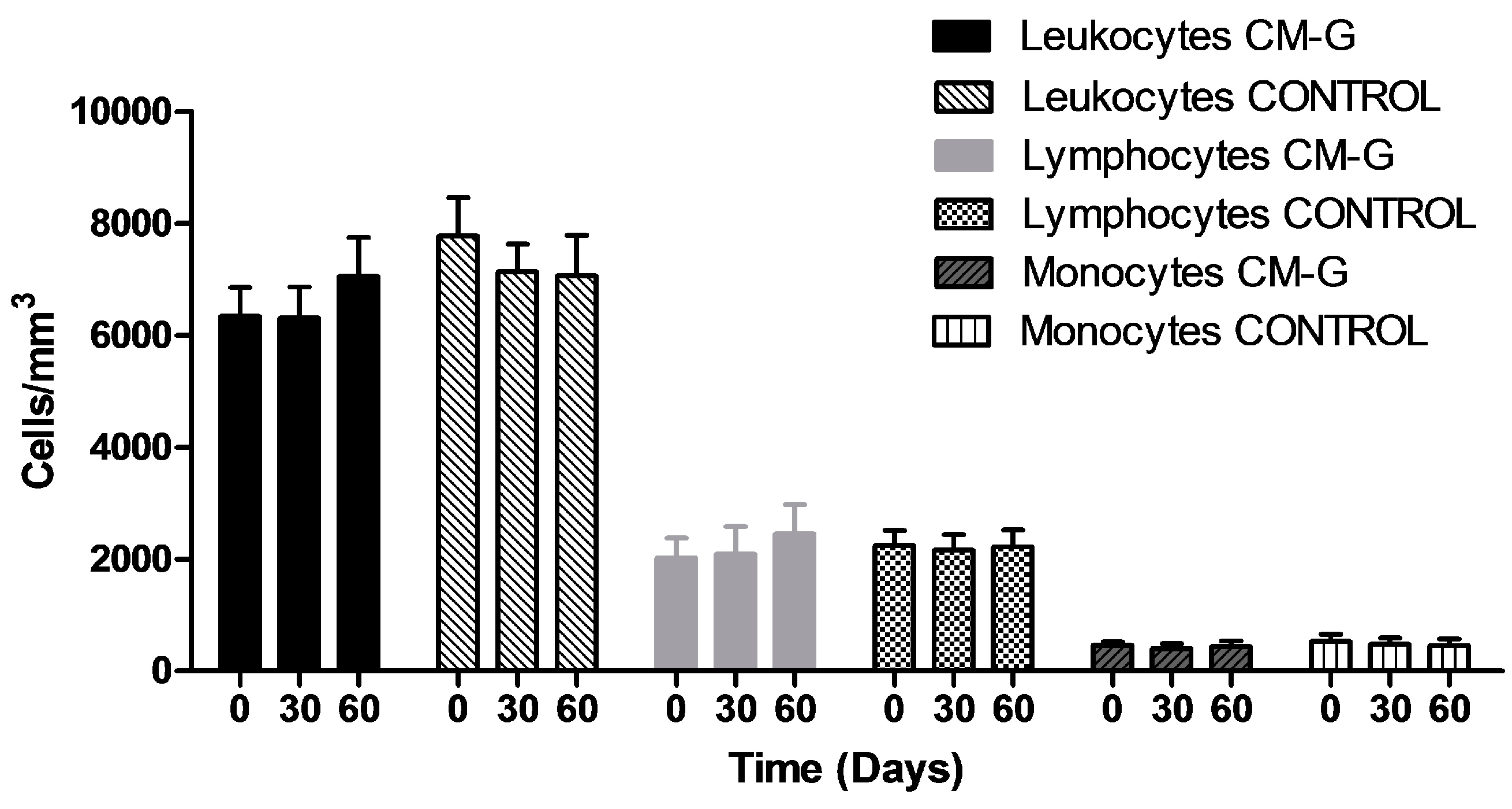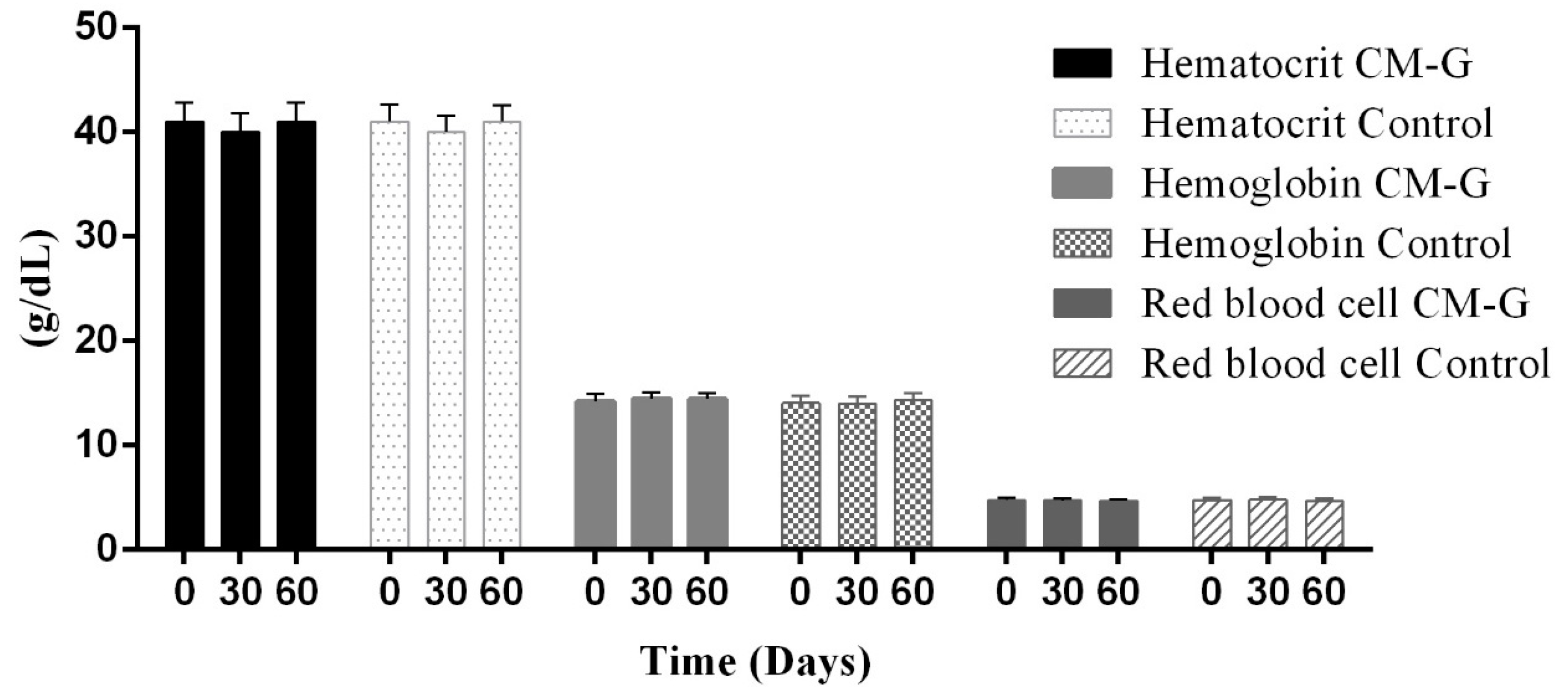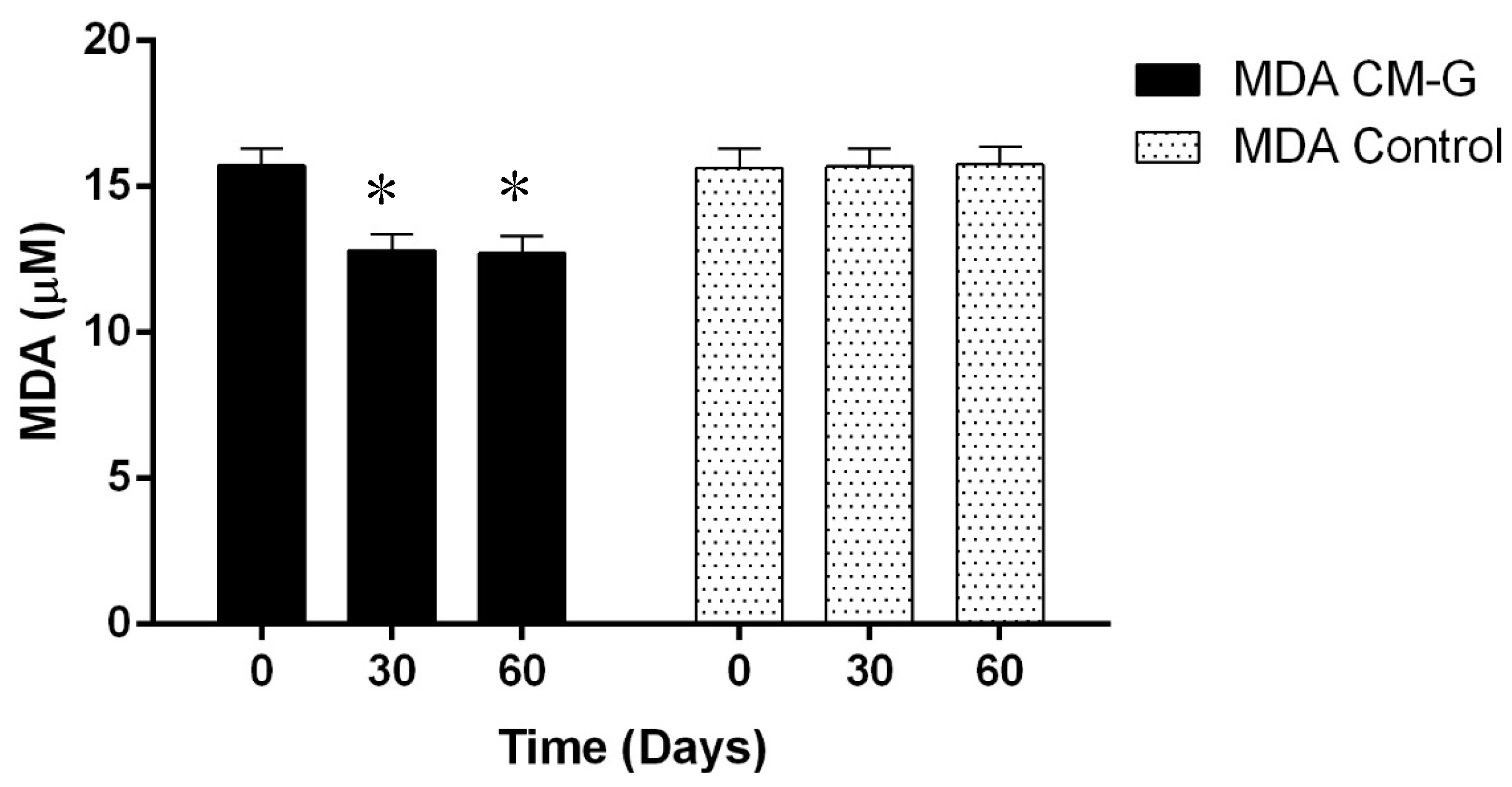Oral Intake of Carboxymethyl-Glucan (CM-G) from Yeast (Saccharomyces uvarum) Reduces Malondialdehyde Levels in Healthy Men
Abstract
:1. Introduction
2. Results and Discussion
| Liver Function | before CMG | after CMG | Reference Value (Method) |
|---|---|---|---|
| Transaminase Aspartate amino transferase (TGO) | 25.1 ± 1 | 24.9 ± 0.9 | 11–41 U/L (automated kinetics) |
| Transaminase Alanine amino transferase (TGP) | 10.2 ± 0.5 | 10.4 ± 0.8 | 7–52 U/L (automated kinetics) |
| Albumin | 3.50 ± 0.75 | 34.30 ± 0.50 | 3.35–5.62 g/dL (capillary electrophoresis) |
| Direct bilirubin | 0.07 ± 0.01 | 0.08 ± 0.02 | up to 0.3 mg/dL (colorimetric) |
| Indirect bilirubin | 0.33 ± 0.12 | 0.32 ± 0.13 | up to 0.7 mg/dL (colorimetric) |
| Alkaline phosphatase | 41.2 ± 10 | 40 ± 9 | 27–100 U/L (automated kinetics) |
| Kidney Function | before CMG | after CMG | Reference Value (Method) |
| Urea | 38 ± 9 | 37 ± 10 | 10–52 mg/dL (automated enzymatic) |
| Creatinine | 0.85 ± 0.23 | 0.89 ± 0.23 | 1.30 mg/dL (automated kinetics) |



3. Experimental Section
3.1. Individuals and Experimental Design
3.2. Extraction of CM-G
3.3. Blood Samples and Analysis
4. Conclusions
Acknowledgments
Author Contributions
Conflicts of Interest
References
- Chen, R.; Seviour, J. Medicinal importance of fungal β-(1→3)(1→6)-glucans. Mycol. Res. 2007, 3, 635–652. [Google Scholar] [CrossRef] [PubMed]
- Magnani, M.; Calliari, C.M.; Macedo, F.C., Jr.; Mori, M.P.; Colus, I.M.S.; Castro-Gomez, R.J.H. Optimized methodology for extraction of (1→3)(1→6)-β-d-glucan from Saccharomyces cerevisiae and in vitro evaluation of the cytotoxicity and genotoxicity of the corresponding carboxymethyl derivative. Carbohydr. Polym. 2009, 78, 658–665. [Google Scholar] [CrossRef]
- Magnani, M.; Castro-Gomez, R.J.H.; Aoki, M.N.; Gregório, E.P.; Libos, F., Jr.; Watanabe, M.A.E. Effects of carboxymethyl-glucan from Saccharomyces cerevisiae on the peripheral blood cells of patients with advanced prostate cancer. Exp. Ther. Med. 2010, 5, 859–862. [Google Scholar] [CrossRef]
- Magnani, M.; Castro-Gomez, R.J.H.; Mori, M.P.; Kuasne, H.; Gregório, E.P.; Libos, F., Jr.; Syllos-Cólus, I.M. Protective effect of carboxymethyl-glucan (CM-G) against DNA damage in patients with advanced prostate cancer. Genet. Mol. Biol. 2011, 1, 131–134. [Google Scholar] [CrossRef] [PubMed]
- Rice, P.J.; Adams, E.L.; Ozment-Skelton, T.; Gonzalez, A.J.; Goldman, M.P.; Lockhart, B.E.; Barker, L.A.; Breuel, K.F.; DePonti, W.R.; Kalbfleisch, J.H.; et al. Oral delivery and gastrointestinal absorption of soluble glucans stimulate increased resistance to infectious challenge. J. Pharmacol. Exp. Ther. 2005, 314, 1079–1086. [Google Scholar] [CrossRef] [PubMed]
- Chorvatovicová, D.; Machova, E.; Sandula, J. Effect of ultrasonicated carboxymethylglucan on cyclophosphamide induced mutagenicity. Mutat. Res. 1996, 371, 115–120. [Google Scholar] [CrossRef]
- Magnani, M.; Castro-Gomez, R.H.; Aoki, M.N.; Gregório, E.P.; Libos, F., Jr.; Morimoto, H.K.; Reiche, E.M.; Watanabe, M.A. Analysis of peripheral T cells and the CC chemokine receptor (CCR5) delta32 polymorphism in prostate cancer patients treated with carboxymethyl-glucan (CM-G). Nat. Prod. Res. 2012, 26, 945–951. [Google Scholar] [CrossRef] [PubMed]
- Slamenová, D.; Laaj, J.; Krizkova, L.; Kogan, G.; Sandula, J.; Bresgen, N.; Eckl, P. Protective effects of fungal (1→3)-β-d-glucan derivatives against oxidative DNA lesions in V79 hamster lung cells. Cancer Lett. 2003, 198, 153–160. [Google Scholar] [CrossRef]
- Kubala, L.; Ruzickova, J.; Nickova, K.; Sandula, J.; Ciz, M.; Lojek, A. The effect of (1→3)-β-d-glucans, carboxymethylglucan and schizophyllan on human leukocytes in vitro. Carb. Res. 2003, 338, 2835–2840. [Google Scholar] [CrossRef]
- Miadoková, E.; Svidova, S.; Vlckova, V.; Duhova, V.; Prazmariova, E.; Tothova, K.; Nadova, S.; Rauko, G.; Kogan, P. The role of natural biopolymers in genotoxicity of mutagens/carcinogens elimination. Biomed. Pap. Med. Fac. Univ. Palacky Olomouc. 2005, 149, 493–496. [Google Scholar] [CrossRef]
- Kogan, G.; Stasko, A.; Bauerova, K.; Polovka, M.; Soltes, L.; Brezova, V.; Navarova, J.; Mihaloa, D. Antioxidant properties of yeast (1-3)-β-d-glucan studied by electron paramagnetic resonance spectroscopy and its activity in the adjuvant arthritis. Carbohydr. Polym. 2005, 61, 18–28. [Google Scholar] [CrossRef]
- Babincová, M.; Bacova, Z.; Machova, E.; Kogan, G. Antioxidant activity of carboxymethyl glucan: Comparative analysis. J. Med. Food. 2002, 5, 79–83. [Google Scholar] [CrossRef] [PubMed]
- Liu, J.; Gunn, L.; Hanses, R.; Yan, J. Combined yeast-derived β-glucan with anti-tumor monoclonal antibody for cancer immunotherapy. Exp. Mol. Pathol. 2009, 86, 208–214. [Google Scholar] [CrossRef] [PubMed]
- Demir, G.; Klein, H.O.; Mandel-Molinas, N.; Tuzuner, N. β-glucan induces proliferation and activation of monocytes in peripheral blood of patients with advanced breast cancer. Int. Immunopharmacol. 2007, 7, 113–116. [Google Scholar] [CrossRef] [PubMed]
- Toklu, H.Z.; Sener, G.; Jahovic, N.; Uslu, B.; Arbak, S.; Yeðen, B.C. β-glucan protects against burn-induced oxidative organ damage in rats. Int. Immunopharmacol. 2006, 6, 156–169. [Google Scholar] [CrossRef] [PubMed]
- Ozkan, O.V.; Ozturk, O.H.; Aydin, M.; Yilmaz, N.; Yetim, I.; Nacar, A.; Oktar, S.; Sogut, S. Effects of β-Glucan pretreatment on acetylsalicylic acid-induced gastric damage: an experimental study in rats. Curr. Ther. Res. 2010, 71, 6. [Google Scholar] [CrossRef]
- Trznadel, K.; Luciak, M.; Pawlicki, L.; Kedziora, J.; Blaszczyk, J.; Buczyinski, A. Superoxide anion generation and lipid peroxidation processes during hemodialysis with reused cuprophan dialyzers. Free Radic. Biol. Med. 1990, 8, 429–432. [Google Scholar] [CrossRef]
- Sener, G.; Toklu, H.; Ercan, F.; Erkanli, G. Protective effect of beta-glucan against oxidative organ injury in a rat model of sepsis. Int. Immunopharmacol. 2005, 5, 1387–1396. [Google Scholar] [CrossRef] [PubMed]
- Wootton-Beard, P.C.; Ran, I. Improving public health: The role of antioxidant-rich fruit and vegetable beverages. Food Res. Int. 2011, 44, 3135–3148. [Google Scholar] [CrossRef]
- Abete, I.; Perez-Cornago, A.; Navas-Carretero, S.; Bondia-Pons, I.; Zulet, M.A.; Martinez, J.A. A regular lycopene enriched tomato sauce consumption influences antioxidant status of healthy young-subjects: A crossover study. J. Funct. Foods 2013, 5, 28–35. [Google Scholar] [CrossRef]
- Weitberg, A. A phase I/II trial of β-(1,3)/(1,6) d-glucan in the treatment of patients with advanced malignancies receiving chemotherapy. J. Exp. Clin. Cancer Res. 2008. [CrossRef] [PubMed]
- Vetvicka, V.; Dvorak, B.; Vetvickova, J.; Richter, J.; Krizan, J.; Sima, P.; Yvin, J.C. Orally administered marine (1→3)-β-d-glucan Phycarine stimulates both humoral and cellular immunity. Int. J. Biol. Macromol. 2007, 40, 291–298. [Google Scholar] [CrossRef] [PubMed]
- Harada, T.; Kawaminami, H.; Miura, N.N.; Adachi, Y.; Nakajima, M.; Yadomae, T.; Ohno, N. Mechanism of enhanced hematopoietic esponse by soluble β-glucan SCG in cyclophosphamide-treated mice. Microbiol Immunol. 2006, 50, 687–700. [Google Scholar] [CrossRef] [PubMed]
- Nicolosi, R.; Bell, S.J.; Bistrian, B.R.; Greenberg, I.; Forse, R.A.; Blackburn, G.L. Plasma lipid changes after supplementation with β-glucan fiber from yeast. Am. J. Clin. Nutr. 999, 70, 208–212. [Google Scholar]
- Brown, G.D.; Gordon, S. Immune recognition of fungal. Cell Microbiol. 2005, 7, 471–479. [Google Scholar] [CrossRef] [PubMed]
- Pospisil, M.; Sandula, J.; Pipalova, I.; Hofer, M.; Viklická, S. Hemopoiesis stimulating and radioprotective effects of carboxymethylglucan. Physiol. Res. 1991, 40, 377–380. [Google Scholar] [PubMed]
- Hofer, M.; Pospisil, M. Glucan as stimulator of hematopoiesis in normal and gamma-irradiated mice. A survey of the authors’ results. Int. J. Immunopharmacol. 1997, 19, 607–609. [Google Scholar] [CrossRef]
- Patchen, M.L.; Vaudrain, T.; Correira, H.; Martin, T.; Reese, D. In vitro and in vivo hematopoietic activities of Betafectin PGG-glucan. Exp Hematol. 1998, 26, 1247–1254. [Google Scholar] [PubMed]
- Turnbull, J.L.; Patchen, M.L.; Scadden, D.T. The polysaccharide, PGG-glucan, enhances human myelopoiesis by direct action independent of and additive to early-acting cytokines. Acta Haematol. 1999, 102, 66–71. [Google Scholar] [CrossRef] [PubMed]
- Pawelec, G.; Lustgarten, J.; Ruby, C.; Gravekamp, C. Impact of aging on cancer immunity and immunotherapy. Cancer Immunol. Immunother. 2009, 58, 1907–1908. [Google Scholar] [CrossRef] [PubMed]
- Guillet, R.; Driss, F.; Perrotin, P.; Pautou, C.; Nalpas, B.; Boynard, M. Gender, menstrual cycle, oral contraceptives and red blood cell deformability in healthy adult subjects. Clin. Hemorheol. Microcirc. 1998, 19, 83–88. [Google Scholar] [PubMed]
- Templar, J.; Kon, S.P.; Milligan, T.P.; Newman, D.J.; Raftery, M.J. Increased plasma malondialdehyde levels in glomerular disease as determined by a fully validated HPLC method. Nephrol. Dial. Transplant. 1999, 14, 946–951. [Google Scholar] [CrossRef] [PubMed]
- Sample Availability: Samples of CM-G are available from the authors.
© 2015 by the authors. Licensee MDPI, Basel, Switzerland. This article is an open access article distributed under the terms and conditions of the Creative Commons Attribution license ( http://creativecommons.org/licenses/by/4.0/).
Share and Cite
Araújo, V.B.d.S.; De Melo, A.N.F.; De Souza, N.T.; Da Silva, V.M.B.; Castro-Gomez, R.H.; Silva, A.S.; De Souza, E.L.; Magnani, M. Oral Intake of Carboxymethyl-Glucan (CM-G) from Yeast (Saccharomyces uvarum) Reduces Malondialdehyde Levels in Healthy Men. Molecules 2015, 20, 14950-14958. https://doi.org/10.3390/molecules200814950
Araújo VBdS, De Melo ANF, De Souza NT, Da Silva VMB, Castro-Gomez RH, Silva AS, De Souza EL, Magnani M. Oral Intake of Carboxymethyl-Glucan (CM-G) from Yeast (Saccharomyces uvarum) Reduces Malondialdehyde Levels in Healthy Men. Molecules. 2015; 20(8):14950-14958. https://doi.org/10.3390/molecules200814950
Chicago/Turabian StyleAraújo, Vilma Barbosa da Silva, Adma Nadja Ferreira De Melo, Neyrijane Targino De Souza, Vânia Maria Barboza Da Silva, Raul H. Castro-Gomez, Alexandre Sérgio Silva, Evandro Leite De Souza, and Marciane Magnani. 2015. "Oral Intake of Carboxymethyl-Glucan (CM-G) from Yeast (Saccharomyces uvarum) Reduces Malondialdehyde Levels in Healthy Men" Molecules 20, no. 8: 14950-14958. https://doi.org/10.3390/molecules200814950






